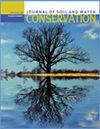密西西比河三角洲尾水回收系统的季节性水质趋势
IF 2.2
4区 农林科学
Q2 ECOLOGY
引用次数: 0
摘要
在密西西比三角洲地区,尾水回收(TWR)系统是解决水质和水量问题的重要最佳管理实践。twr是地表水捕获和灌溉再利用系统,使用沟渠捕获地表水,农场储存(OFS)水库储存捕获的地表水,以及泵将地表水从沟渠转移到OFS水库并灌溉附近的田地。为了确定TWR系统是否是减少用水量和下游养分负荷的有效方法,对密西西比州向日葵县沟渠和池塘TWR系统的水质和水量数据进行了为期五年的测量。本研究的目的是评估TWR系统的季节性径流和径流水质趋势。除叶绿素a外,其他水质参数均有明显的季节变化。溶解氧(DO)、固形物、电导率、总溶解有机碳(TDOC)、总磷(TP)和总凯氏定氮(TKN)在OFS水库和沟渠站点之间存在显著差异。根据季节的不同,沟渠中的固体总量是水库中的2至4倍,这表明农田通过径流流失的沉积物不一定会通过水库的灌溉返回农田。沟渠中的营养物质也普遍高于水库。春季沟内磷(PO4)含量比水库高1.4倍,夏季沟内铵(NH4)和硝(NO3)含量比水库高2 ~ 4倍。这些结果表明,水库通过沉降、营养物质的生物吸收和生物地球化学转化对营养物和沉积物起着重要的处理作用,并强调了封闭TWR系统的重要性。本文章由计算机程序翻译,如有差异,请以英文原文为准。
Seasonal water quality trends in a tailwater recovery system in the Mississippi Delta
In the Mississippi Delta region, tailwater recovery (TWR) systems are an important best management practice to address both water quality and quantity issues. TWRs are surface water capture-and-irrigation reuse systems using a combination of a ditch to capture surface water, an on-farm storage (OFS) reservoir to store captured surface water, and pumps to move surface water from the ditch into the OFS reservoir and to irrigate nearby fields. To determine if TWR systems are an effective way to reduce water use and downstream nutrient loads, water quality and quantity data from a ditch and pond TWR system in Sunflower County, Mississippi, were measured for five years. Objectives of this study were to assess seasonal TWR system runoff and runoff water quality trends. All water quality parameters had clear seasonal variation, except for chlorophyll a. Dissolved oxygen (DO), solids, conductivity, total dissolved organic carbon (TDOC), total phosphorus (TP), and total Kjeldahl nitrogen (TKN) exhibited significant differences between OFS reservoir and ditch sites. Total solids were 2 to 4 times higher in the ditch than in the reservoir, depending on the season, indicating sediment lost from fields through runoff is not necessarily returned to the fields via irrigation from the reservoir. Nutrients were also generally higher in the ditch than in the reservoir. Phosphate (PO4) was 1.4 times higher in the ditch in spring compared to the reservoir, while ammonium (NH4) and nitrate (NO3) were 2 to 4 times higher in the ditch during the summer. These results suggest the reservoir serves an important function to process nutrients and sediments through settling, biological uptake of nutrients, and biogeochemical transformations and emphasizes the importance of a closed TWR system.
求助全文
通过发布文献求助,成功后即可免费获取论文全文。
去求助
来源期刊
CiteScore
4.10
自引率
2.60%
发文量
0
审稿时长
3.3 months
期刊介绍:
The Journal of Soil and Water Conservation (JSWC) is a multidisciplinary journal of natural resource conservation research, practice, policy, and perspectives. The journal has two sections: the A Section containing various departments and features, and the Research Section containing peer-reviewed research papers.

 求助内容:
求助内容: 应助结果提醒方式:
应助结果提醒方式:


